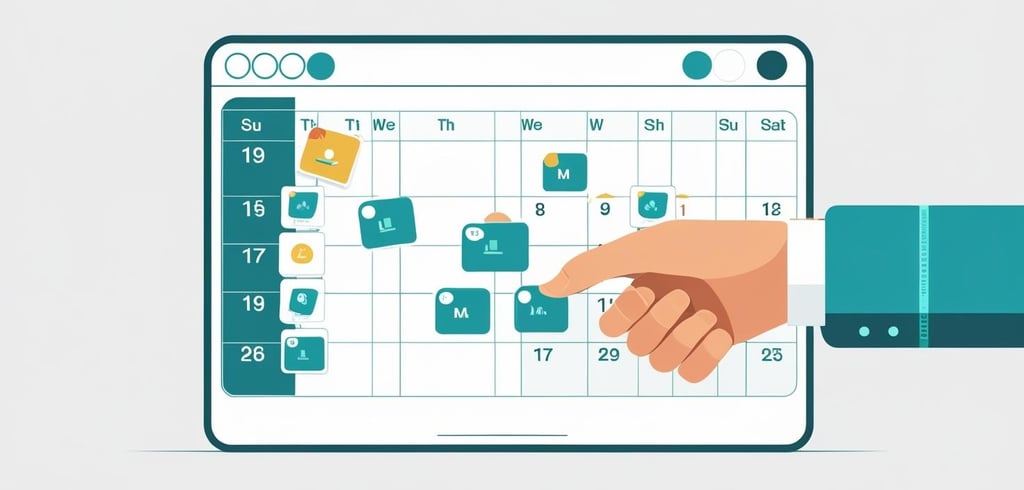Start sending invites for free - no card required - Click here
Why Bulk Calendar Invites Are the Backbone of Modern Scheduling
Coordinating today’s fast-moving meetings, webinars, and multi-session events demands more than copy-and-paste artistry. Manually adding each participant drains hours and multiplies the risk of errors. A well-crafted bulk calendar invite eliminates that burden by turning dozens—or thousands—of separate notifications into one unified action. In this guide you’ll discover when to use bulk scheduling, how to send mass calendar invites with confidence, and what habits keep large-scale coordination running smoothly.
BLOGS
6/17/20252 min read


Coordinating today’s fast-moving meetings, webinars, and multi-session events demands more than copy-and-paste artistry. Manually adding each participant drains hours and multiplies the risk of errors. A well-crafted bulk calendar invite eliminates that burden by turning dozens—or thousands—of separate notifications into one unified action. In this guide you’ll discover when to use bulk scheduling, how to send mass calendar invites with confidence, and what habits keep large-scale coordination running smoothly.
1. Efficiency: The Hidden Cost Saver
Administrative time is expensive. When organizers must key in addresses one at a time, preparation balloons and productivity shrinks. With bulk meeting invites, the calendar entry itself becomes a living document: change the date, location, or dial-in link once and every participant’s agenda updates automatically. Over the course of a year, trimming a few minutes from each event can reclaim entire workdays.
2. Planning Questions Before You Press “Send”
Is your recipient list clean? Remove duplicates and respect opt-out requests.
Are time zones covered? Schedule at a universally reasonable hour or offer multiple slots.
Is the value proposition clear? A concise title and objective boost acceptance rates.
Do you need sub-events? Breakouts or rehearsal sessions might warrant separate entries.
Addressing these factors first makes it easier to send bulk calendar invite messages without second-guessing later.
3. The Step-by-Step Framework
Gather addresses in a single source—spreadsheet, CRM export, or group list.
Draft your invite: title, start and end times, location or link, and a tight agenda.
Attach supporting material sparingly; excessive files slow delivery.
Proof and test by sending to yourself and a colleague.
Dispatch to all recipients, instantly completing what used to take hours.
If you ever need to send bulk meeting invite adjustments—such as a new room or updated start time—edit once and let the calendar platform propagate those details.
4. Best Practices for High Acceptance
Segment smartly: senior leadership may need extra context; interns may need baseline resources.
Respect privacy: hide attendee lists for sensitive gatherings.
Highlight next steps: make it easy for guests to confirm, prepare, or delegate.
A polished description also encourages more people to send bulk meeting invites in gmail to colleagues who need the information but weren’t on the original list.
5. Monitoring Success Without Extra Software
Even the most basic calendar systems provide acceptance data. After you send mass meeting invites, track:
Accepted vs. declined counts
No-response percentages
Late cancellations that may hint at overbooked schedules
Reviewing these metrics clarifies whether your timing, title, or agenda resonates with recipients.
6. Beyond the Send: Sustaining Engagement
Bulk invites aren’t “fire and forget.” Follow-ups matter:
24-hour reminder: a friendly nudge reinforces attendance.
Agenda recap: highlights key talking points so everyone arrives prepared.
Post-event summary: actionable insights attached to the original calendar entry close the loop.
These touches show respect for participants’ schedules and uphold the standard you set when you first chose to send mass calendar invites.
Conclusion
Large-group coordination no longer requires marathon data entry or endless email threads. Mastering the use of a bulk calendar invite turns scheduling into a strategic advantage: organizers gain back time, participants stay informed, and organizations deliver smoother, more professional events. Adopt the framework above, refine it to your workflows, and watch administrative chaos transform into predictable, repeatable success.
BulkCalendar.in
Send Bulk & Mass Calendar Invites Instantly
Contact us
Engagement
sales@letscalendar.com
+44 (0) 203 916 5117
© 2025. All rights reserved.
Help?
